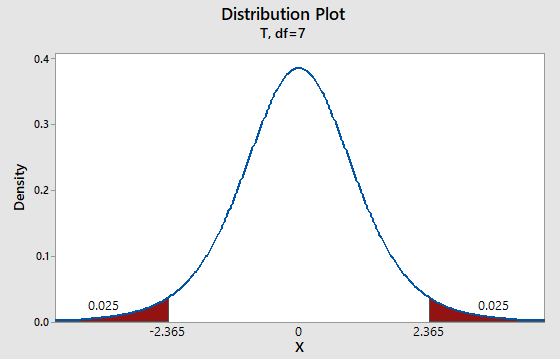
(a)
The level of significance, null and alternative hypothesis & determine whether we should use a left-tailed, right-tailed, or two-tailed test.
(a)
Answer to Problem 19P
Solution: The level of significance is
Explanation of Solution
The level of significance is defined as the probability of rejecting the null hypothesis when it is true, it is denoted by
Null hypothesis
Alternative hypothesis
Since
(b)
To find: The sampling distribution that should be used along with assumptions and compute the value of the sample test statistic.
(b)
Answer to Problem 19P
Solution: The sampling distribution of
Explanation of Solution
Calculation:
| A | B | |||
| 21 | 24 | -3 | 0.5625 | |
| 25 | 23 | 2 | 18.0625 | |
| 20 | 25 | -5 | 7.5625 | |
| 14 | 18 | -4 | 3.0625 | |
| -4 | 6 | -10 | 60.0625 | |
| 19 | 4 | 15 | 297.5625 | |
| 15 | 21 | -6 | 14.0625 | |
| 30 | 37 | -7 | 22.5625 | |
| Sum | 140 | 158 | -18 | 423.5 |
| Average | 17.5 | 19.75 | -2.25 | 52.9375 |
The d distribution is mound shaped and symmetrical and we have a random sample of
Using
(c)
To find: The critical value of the test statistic and sketch the sampling distribution showing the critical region.
(c)
Answer to Problem 19P
Solution: The critical value of the test statisticis
Explanation of Solution
Calculation:
The level of significance is
95% of the t-distribution curve lies between -
Using table 4 from Appendix we get
Critical region is
Graph:
To draw the required graphs using the Minitab, follow the below instructions:
Step 1: Go to the Minitab software.
Step 2: Go to Graph > Probability distribution plot > View probability.
Step 3: Select ‘t’ and d.f = 7.
Step 4: Click on the Shaded area > Probability.
Step 5: Select ‘Both tail’ and enter Probability as 0.05.
Step 6: Click on OK.
The obtained distribution graph is:

Interpretation:
If the value of the sample test statistics lies in the critical region then we have to reject the null hypothesis.
(d)
Whether we reject or fail to reject the null hypothesis and whether the data is statistically significant for a level of significance of 0.05.
(d)
Answer to Problem 19P
Solution: The t-value (- 0.82) does not lie in the critical region. The data is not statistically significant for a level of significance of 0.05
Explanation of Solution
The critical regionis
The t-value (- 0.82)does not lie in the critical region. Therefore we don’t have enough evidence to reject the null hypothesis
(e)
The interpretation for the conclusion.
(e)
Answer to Problem 19P
Solution: There is not enough evidence to conclude that the populations mean percentage increase in corporate revenue is different from the population mean percentage increase in CEO salary.
Explanation of Solution
The t-value (- 0.82) does not lie in the critical region. Therefore we don’t have enough evidence to reject the null hypothesis
(f)
The comparison for our conclusion with the conclusion obtained from the P-value method.
(f)
Answer to Problem 19P
Solution: Both the conclusions are same.
Explanation of Solution
The conclusion from the P-value method is:
The P-value of 0.4392 is greater than the level of significance (
Since we are using the same significance level of 0.05, hence both the conclusions will be same.
Want to see more full solutions like this?
Chapter 10 Solutions
EBK UNDERSTANDING BASIC STATISTICS
- A marketing agency wants to determine whether different advertising platforms generate significantly different levels of customer engagement. The agency measures the average number of daily clicks on ads for three platforms: Social Media, Search Engines, and Email Campaigns. The agency collects data on daily clicks for each platform over a 10-day period and wants to test whether there is a statistically significant difference in the mean number of daily clicks among these platforms. Conduct ANOVA test. You can provide your answer by inserting a text box and the answer must include: also please provide a step by on getting the answers in excel Null hypothesis, Alternative hypothesis, Show answer (output table/summary table), and Conclusion based on the P value.arrow_forwardA company found that the daily sales revenue of its flagship product follows a normal distribution with a mean of $4500 and a standard deviation of $450. The company defines a "high-sales day" that is, any day with sales exceeding $4800. please provide a step by step on how to get the answers Q: What percentage of days can the company expect to have "high-sales days" or sales greater than $4800? Q: What is the sales revenue threshold for the bottom 10% of days? (please note that 10% refers to the probability/area under bell curve towards the lower tail of bell curve) Provide answers in the yellow cellsarrow_forwardBusiness Discussarrow_forward
- The following data represent total ventilation measured in liters of air per minute per square meter of body area for two independent (and randomly chosen) samples. Analyze these data using the appropriate non-parametric hypothesis testarrow_forwardeach column represents before & after measurements on the same individual. Analyze with the appropriate non-parametric hypothesis test for a paired design.arrow_forwardShould you be confident in applying your regression equation to estimate the heart rate of a python at 35°C? Why or why not?arrow_forward
 Glencoe Algebra 1, Student Edition, 9780079039897...AlgebraISBN:9780079039897Author:CarterPublisher:McGraw Hill
Glencoe Algebra 1, Student Edition, 9780079039897...AlgebraISBN:9780079039897Author:CarterPublisher:McGraw Hill Holt Mcdougal Larson Pre-algebra: Student Edition...AlgebraISBN:9780547587776Author:HOLT MCDOUGALPublisher:HOLT MCDOUGAL
Holt Mcdougal Larson Pre-algebra: Student Edition...AlgebraISBN:9780547587776Author:HOLT MCDOUGALPublisher:HOLT MCDOUGAL Big Ideas Math A Bridge To Success Algebra 1: Stu...AlgebraISBN:9781680331141Author:HOUGHTON MIFFLIN HARCOURTPublisher:Houghton Mifflin Harcourt
Big Ideas Math A Bridge To Success Algebra 1: Stu...AlgebraISBN:9781680331141Author:HOUGHTON MIFFLIN HARCOURTPublisher:Houghton Mifflin Harcourt


